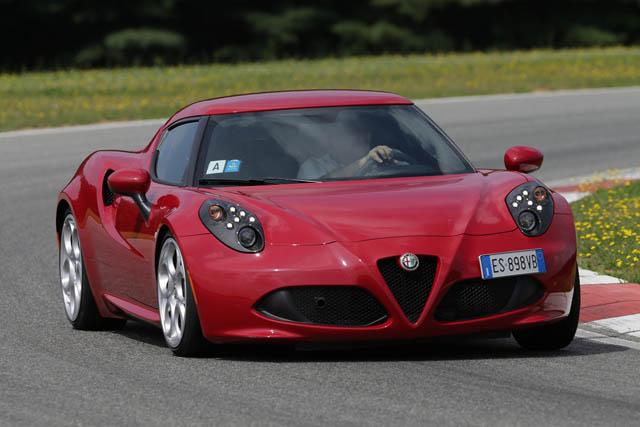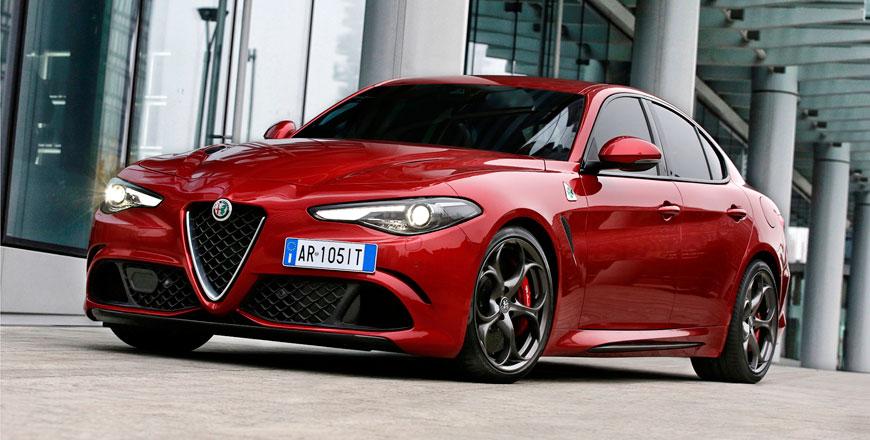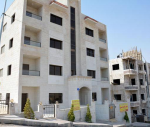You are here
Lusty and lightweight
By Ghaith Madadha - Aug 11,2014 - Last updated at Aug 11,2014

Among the most hallowed of automotive brands Alfa Romeo has been responsible for some of the most evocative and beloved cars to grace the road. On the cusp of model expansion and overhaul that will see it become the BMW-rivalling premium brand among its’ Fiat-Chrysler parent company’s portfolio, the Alfa Romeo 4C stands as a sort of figurehead or purist expression of revered Italian brand’s sporting lineage and values.
A lusty, raw and ultra lightweight mid-engine two-seater the 4C is a bona fide sports car successor to Alfa’s larger, more luxurious and indulgent 8C halo model. Utilising assiduous weight-saving measures, contemporary high-tech solutions and lasciviously racy styling, the 4C is in spirit a miniature exotic Italian super car.
Precise packaging
Hand built on dedicated production lines at Maserati’s Modena plant like its rarer V8-engined Alfa 8C predecessor, the 4C is however less extravagantly-priced and isn’t based on a shortened Maserati platform. Instead it uses a bespoke carbon-fibre monocoque and aluminium subframes. Weighing just 65kg, the Alfa 4C’s lightweight carbon-fibre monocoque also provides the suspension with a rigid platform to deliver enhanced handling and ride.
Built to extract performance and handling ability through weight reduction and compact size the Alfa 4C’s design, construction and components reflects this Lotus-like ethos of ‘adding lightness’. With compounded benefits weight reduction allows for the use of yet lighter components, like un-assisted rack and pinion and four-cylinder engine to great effect.
A more affordable Italian exotic and darty compact sports car, the Alfa 4C’s design, construction and components also take packaging and production and running costs into careful consideration. To fit into its tight centre engine bay the Alfa 4C is driven by a transversely-mounted 1.75-litre turbocharged engine and shorter and wider 6-speed automated dual-clutch gearbox, lifted and modified from service in the front-drive Alfa Romeo Giulietta QV hatchback.
Using sophisticated double wishbone front suspension and hardcore four-piston Brembo brakes in front, the 4C rationally incorporates better packaged and less costly MacPherson strut rear suspension — suitably evolved for sports car application — and single-piston brakes. Similarly light alloy wheels are mated to slimmer and better feeling 205/40R18 front tyres.
Prodigious four-pot power
Powered by a lighter aluminium block version engine also used in the Giulietta QV, the prodigious 1.75-litre turbocharged unit also sees revised intake and exhaust manifolds and the use of crankshaft counterweights rather than balancing shafts for service in the 4C.
However it retains the wet-sump lubrication — presumably for less weight, cost and complexity and better packaging — rather than a lower centre-of-gravity dry-sump. With low weight, aggressive gearing and clever ‘scavenging’ technology to reduce lag and allow its turbo to spool up swiftly the 4C is quick off-the-line.
And with 80 per cent of maximum torque at 1700rpm and the full 258lb/ft available throughout a broad 2200-4250rpm band, the 4C’s on-the-move acceleration and flexibility are muscular, effortless and flexible.
Riding on a rich wave of mid-range torque, 4C viciously builds-up towards its maximum 237BHP at 6000rpm and can tear through the 0-100km/h sprint in 4.5-seconds (4.2-seconds according to some unofficial accounts) and onto a 258km/h maximum — during test drive at Alfa Romeo’s Balocco proving grounds near Turin, the 4C would touch 200km/h with remarkable verve.
Aggressively boosted at 1.45-bar, the 4C’s engine surges ferociously at high revs, and calming just after throttle lift-off from near its 6500rpm redline. Nestled intimately behind the driver with little noise buffering, the raspy four-pot engine rips through revs ever more audibly. Satisfyingly overlapped with induction hissing and turbo whine, acoustics are punctuated by dump-valve huffs, chirps and crackles.
Responsive reflexes
An agile corner carving hero, the 895kg flyweight Alfa 4C is at its best as it rapidly negotiates fast bends, tight corners and chicanes. With its firm suspension, low profile tyres and road-hugging wide track, the low-slung 4C corners with poised flat body control and through chicanes, sudden weight transfers are well managed.
A tiny sports car measuring 3,989mm long and with a 2,380mm wheelbase, the Alfa 4C zips through winding track sections with zippy and eager agility, while un-assisted steering delivers accurate feel and feedback. Somewhat light for a couple of degrees from on-centre, the 4Cs weighs up nicely when loaded up through a tight bend, and delivers tactile feel for the road and the car’s grip limits.
Flicking the direct and quick 2.7-turn steering into a corner, the 4C turns in tidily and crisply, with good feel and grip delivered from its slim front tyres, and with automated dual clutch paddle-shifters mean one rarely needs to take hands off the wheel. But if pushed too fast and too hard into a turn, a faint hint of under-steer gives warning of grip limits, while meatier 235/35R19 rear tyres provide vice-like grip, especially when loaded up through corners.
That said, the 4C doesn’t seem averse to tightening its cornering line by playfully twitching out the rear slightly on throttle lift-off to correct under-steer, but one didn’t really explore this much as track driving was done with stability controls on.
Using an electronic limited-slip differential rather than a mechanical component that would add weight, cost and complexity within its tight engine bay, the Alfa 4C’s system works by selectively braking the spinning inside wheel to mimic a mechanical system.
The trade-off for its turbocharged power, weight-saving and economy and efficiency advantages is that the 4C’s throttle control isn’t as crisply precise and responsive as a well-sorted naturally aspirated engine throughout the rev range.
For best cornering fluency, precision, predictability and grip, one needs to keep the 4C in its sweet and responsive mid-range when boost is building, and avoid low-rev lag or sudden high rev surge when dialling in power for on-throttle exit from a corner’s apex.
Driver-focused
Though a small car, the Alfa 4C’s comfortable and supportively seats larger and taller drivers with adjustable sports seat and adjustable chunky steering wheels and headroom, while access over wide sills is easy. To save weight the 4C uses simple mats over exposed carbon and thinly padded seats and dashboard, while the passenger seat is fixed.
Steering-mounted paddle-shifters allow one to manually fire-off the 6-speed dual clutch gearbox’s seamlessly crisp cog changes without taking hands off the wheel, while Alfa’s DNA driving mode selector allows one to sharpen up throttle and gearbox responsiveness in Race mode. Cabin layout is driver-focused with controls within easy reach and a driver-tilted centre console with the optional A/C controls.
With hunkered down cabin, muscularly curvy rear haunches, round rear lights and side intakes, the Alfa 4C’s design is a tightly paged and evocative take on the classic mid-engine Italian sports car. From shield-like grille, optional telephone dial alloy wheels, across its bonnet, roofline and flanks, the 4C emits a sense of dynamic tension and is viewed best when in motion, and more specifically when showing off its agile cornering ability.
Though pared down and lightweight, the 4C’s cabin features stylish leathers, while a 110-litre storage compartment offers a measure of practicality. Firm but not uncomfortable and stable at high speed on a smooth track, the 4C has good front visibility for precisely positioning, but rear visibility is limited.
TECHNICAL SPECIFICATIONS
Engine: 1.75-litre, turbocharged 4-cylinders
Bore x stroke: 83 x 80.5mm
Compression ratio: 9.5:1
Valve-train: 16-valve, DOHC, variable valve timing, direct injection
Maximum boost: 1.45-bar
Layout: mid-mounted, transverse
Gearbox: 6-speed automated dual-clutch, rear-wheel-drive
Gear ratios: 1st 4.154:1; 2nd 2.269:1; 3rd 1.435:1; 4th 0.978:1; 5th 0.755:1; 6th 0.622:1
Final drive: 4.118:1
Power, BHP (PS) [kW]: 237 (240) [177] @ 6000rpm
Specific power: 136BHP/litre
Power -to-weight ratio: 264.8BHP/tonne
Torque, lb/ft (Nm): 258 (350) @ 2200-4250rpm
Specific torque: 101Nm/litre
Torque-to-weight ratio: 391Nm/tonne
0-100 km/h: 4.5-seconds
Top speed: 258km/h
Weight distribution, F/R: 41 per cent/59 per cent
Construction: Carbon-fibre monocoque, aluminium subframes
Suspension, F/R: Double wishbones anti-roll bars/MacPherson struts
Steering: Rack & pinion
Lock-to-lock: 2.7-turns
Turning circle: 12.1-metres
Brakes, F/R: Perforated, ventilated discs, 305mm/292mm
Brake callipers, F/R: 4-/1-piston
Braking, 100-0km/h: 36-metres
Maximum lateral acceleration: 1.1g
Tyres, F/R: 205/40R18/235/35R19 (optional)
Related Articles
Stylishly designed and appointed inside, the Giulietta Quadrifoglio Verde is the updated hot version of Alfa Romeo’s C-segment family hatchback. First introduced as the Giulietta 1740 TBi in 2010 and face-lifted as the Qudrifoglio Verde — or QV — earlier this year, the Alfa hot hatch receives a 5BHP power hike, aluminium engine block and twin-clutch automated gearbox, all shared with Alfa’s compact mid-engine 4C halo sports car.
Back in the business of making stylishly sexy sports and super saloons after a brief hiatus of concentrating on sports cars and hatchbacks,
The high performance version of Alfa Romeo’s resurrected Giulia sports saloon model line, the Quadrifoglio is the curviest and most visceral


















